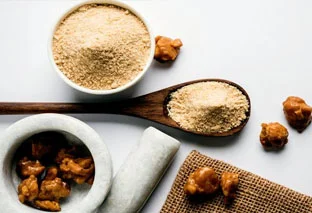Uncover the secrets of hing, a staple in every Indian household. From its bold, aromatic flavor that elevates dishes to its impressive health benefits, learn why this unique spice holds a cherished place in Indian kitchens and traditional recipes. Explore its history, uses, and the cultural significance that makes hing an irreplaceable ingredient in Indian cooking.
What are the health benefits of using hing in daily cooking?
Short Answer: Hing (asafoetida) offers various health benefits, including aiding digestion, reducing bloating, and possessing antimicrobial properties.
Long Answer: Hing, also known as asafoetida, is not only a flavorful spice but also a powerhouse of health benefits. Here are some key health benefits of using hing in daily cooking:
- Aids Digestion: Hing stimulates the digestive enzymes and helps reduce bloating and gas.
- Antimicrobial Properties: It has natural antibiotic properties that can help fight off various infections.
- Anti-inflammatory Effects: Hing contains compounds that have anti-inflammatory properties, aiding in reducing inflammation in the body.
- Relieves Respiratory Issues: It can help alleviate symptoms of asthma, bronchitis, and other respiratory conditions.
- Menstrual Health: Hing is known to help with menstrual cramps and irregularities.
How does hing enhance the flavor of dishes?
Short Answer: Hing adds a distinct umami flavor and aroma to dishes, enhancing their overall taste profile.
Long Answer: The unique flavor of hing, often described as pungent, is transformative when added to cooking. Here are ways hing enhances the flavor of dishes:
- Umami Flavor: Hing imparts a savory, umami taste that deepens the flavor of the dish.
- Balancing Act: It helps balance the flavors, especially in vegetarian dishes, by adding a meaty depth.
- Aroma: Hing’s strong aroma mellows down when cooked, adding a subtle fragrance that enhances the dish.
- Spice Synergy: It complements other spices, bringing out their flavors more distinctly.
- Reduced Need for Onions and Garlic: It can be used as a substitute for onions and garlic, providing similar benefits without overpowering the dish.
Are there any traditional recipes that highlight the use of hing?
Short Answer: Yes, traditional recipes like dal tadka, kadhi, and various pickles prominently feature hing.
Long Answer: Hing has been a cornerstone in traditional Indian recipes for centuries. Here are a few traditional recipes where hing plays a crucial role:
- Dal Tadka: Hing is used in the tempering for dal tadka, adding a rich flavor to the lentils.
- Kadhi: In this yogurt-based curry, hing is often added in the tempering to enhance the flavor.
- Pickles: Hing is a common ingredient in various Indian pickles, contributing to their distinctive taste.
- Sambar: This South Indian lentil stew benefits from the inclusion of hing in its spice mix.
- Chutneys: Hing is often used in chutneys to add depth and balance to the flavors.
What are the different forms of hing available in the market and which one is best for cooking?
Short Answer: Hing is available in two primary forms: resin and powder. Powdered hing is more convenient and commonly used in cooking.
Long Answer: Hing comes in various forms, each with its specific uses. Here are the different forms of hing available in the market:
| Form | Description | Best Use |
|---|---|---|
| Resin | A solid form that requires grating or dissolving in water before use. | Authentic and traditional dishes where a strong flavor is needed. |
| Powder | Ground form mixed with wheat flour or gum Arabic for ease of use. | Everyday cooking due to its convenience and ease of measuring. |
| Granules | A granular form that dissolves easily in hot oil or water. | Quick recipes requiring fast dissolution. |
Can hing be used as a substitute for other spices? If so, how?
Short Answer: Yes, hing can substitute for onions and garlic, providing similar flavors without overpowering the dish.
Long Answer: Hing is a versatile spice that can be used as a substitute for other spices. Here’s how it can be effectively substituted:
- Onions and Garlic: Hing can replace onions and garlic, especially in dishes for those who avoid them due to dietary restrictions.
- Flavor Enhancement: It can be used to enhance the flavor of dishes where spices like cumin or mustard seeds are typically used.
- Low FODMAP Diets: Hing is suitable for people following low FODMAP diets, where onions and garlic are restricted.
- Indian Curries and Lentils: Adding a pinch of hing to curries and lentils can provide a similar depth of flavor as other aromatic spices.
- Aromatic Spice Blends: Hing can be added to spice blends to enhance their overall aroma and taste.
Conclusion
In conclusion, hing is an indispensable spice in Indian households, valued for its health benefits, unique flavor, and versatility in cooking. Whether used in traditional recipes or as a substitute for other spices, hing’s ability to enhance dishes while promoting well-being makes it a staple in every kitchen. Understanding the different forms of hing and their applications can help you make the best use of this ancient spice in your culinary adventures.

